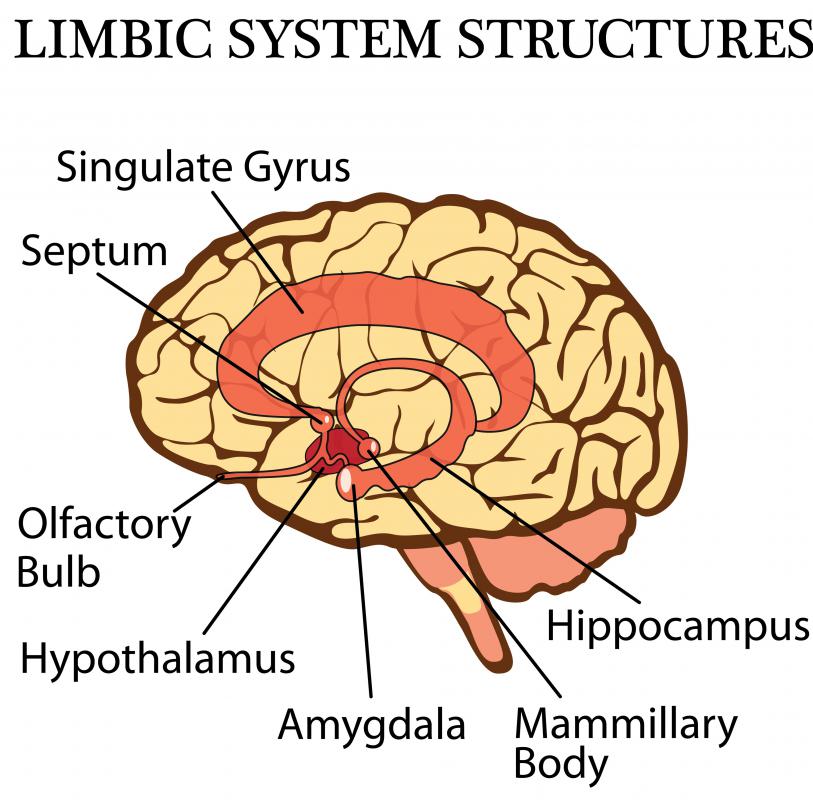At WiseGEEK, we're committed to delivering accurate, trustworthy information. Our expert-authored content is rigorously fact-checked and sourced from credible authorities. Discover how we uphold the highest standards in providing you with reliable knowledge.
What is the Relationship Between Panic Attacks and the Amygdala?
While there is no consensus among researchers and mental health professionals about the degree to which a panic attack results from biological, psychological or environmental factors, it is generally accepted that all three play a role. From a biological point of view, of most interest is the amygdala, a part of the limbic system deep in the brain that harbors memories, sensations and emotions, processes the experience of fear and drives behavior. In some individuals, certain stimuli spur the amygdala to work with the most primal part of the brain — the so-called reptilian brain — to cause the sympathetic nervous system to behave in ways that result in a panic attack.
Neurotransmitters, chemicals that transfer information from one part of the brain to the other, play a crucial role in the messages that the amygdala receives and in the instructions that it sends out to the rest of the body. In the case of a panic attack, a type of anxiety, the amygdala misinterprets certain signals, leading to behavior that is not at all warranted by the situation at hand. In these instances, the amygdala might invoke the fight-or-flight instinct or generate other extreme symptoms of panic. An individual might experience things such as a pounding heart, sweating, trembling, shortness of breath, chest pain, nausea, chills or hot flashes. He or she also might have paralyzing fear, a fear of losing control or even a fear of imminent death.
The symptoms of a panic attack are usually short-lived, often lasting for only a few minutes. In some cases, however, an attack can last for hours. Another symptom is a fear of when the next panic attack will occur.

Panic attacks differ from other forms of anxiety not only in their brevity but in that they are episodic. When panic attacks become frequent or disruptive enough, however, they comprise full-fledged panic disorder. There is no general agreement about what triggers a panic attack, but some specialists in anxiety and panic disorders maintain that the intense, momentary discomfort is a manifestation of the memory of powerlessness that a person experienced as an infant or very young child.

Experts believe that the amygdala learns to respond to stimuli in specific ways, and in certain individuals, one of those ways is a panic attack. Research into anxiety disorders over the years has concentrated on the use of cognitive behavioral therapy — behavior modification — to retrain the amygdala to respond to apparent anxiety- and panic-inducing stimuli in a more appropriate manner. This form of therapy provides a framework for the patient to challenge, with the therapist’s guidance, negative thought patterns and self-defeating behaviors. In addition to treating panic attacks, behavior modification has proved to be effective in addressing the many phobias that sometimes are related to panic disorder.

Other mental health professionals have developed different therapies that might be effective in treating panic disorder. In some cases, anti-anxiety medications or antidepressants might prove beneficial. They might not effect permanent change in the amygdala itself, however.
Although about 10 percent of the United States' population will experience at least one transient panic attack, about 4 million Americans suffer from panic disorder. Worldwide, it is estimated that anxiety disorders, including panic disorder, might affect more than 80 million people. Field surveys, however, are far from complete.
AS FEATURED ON:
AS FEATURED ON:















Discussion Comments
I have a patient who suffers with extreme anxiety, and thinks people are watching him when he walks down the road or into a store. I feel his amygdala is at fault.
I do hypnotherapy and counseling with him once a week, but he can't stop his "what if" or "they're looking at me...act normal, act normal, act normal." Consequently, he is acting anything but normal, always searching the street or room in case he is being noticed.
Does anyone have any ideas of how I can help him since this is so extreme? He is tall and good-looking and maintains eye contact with me, but says he finds it hard to do with others. He is amusing but sees himself quite differently from how he actually comes across to me.
Post your comments